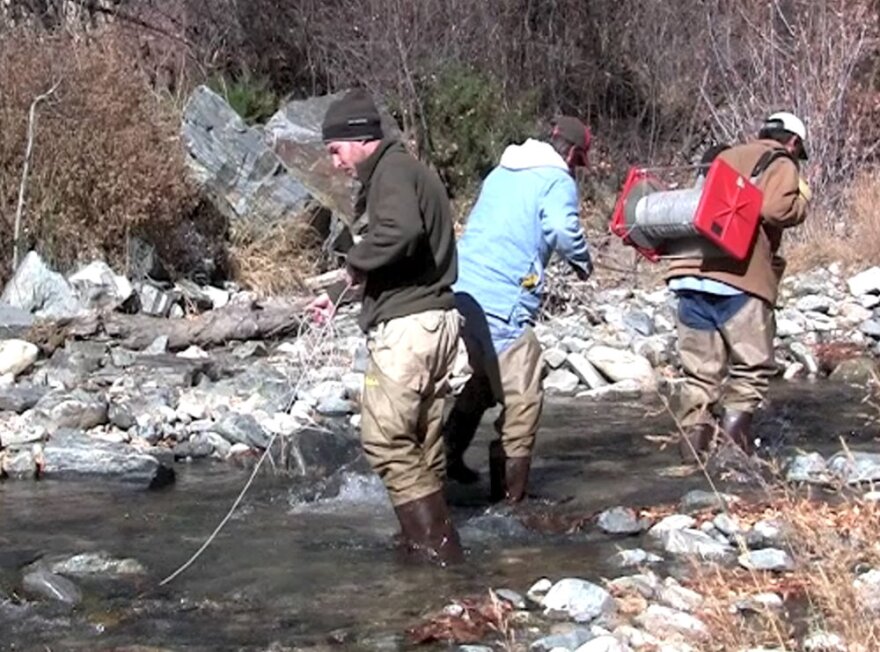An in-depth study of centuries-old community acequia systems in northern New Mexico reveals why they have been resilient.
Since 2010, researchers from New Mexico State University, University of New Mexico, and Sandia National Laboratory have studied hydrology and cultural aspects of the of El Rito, Rio Hondo and Alcalde acequia systems.
“We wanted to understand the many facets involved in the operation of these systems and what contributes to their resiliency, not just the hydrology,” said Sam Fernald, professor in NMSU’s Department of Animal and Range Sciences. “I think we found out some of those, including the importance of the culture of the community.”
Fernald is the principal investigator of “Acequia Water Systems Linking Culture and Nature: Integrated Analysis of Community Resilience to Climate and Land Use Changes,” a research project funded by a $1.4 million grant from the National Science Foundation.
All around the world, community-based flood irrigation systems, owned and managed by self-organized farmers, deliver the natural resource of water to sustain agriculture during scarce or uneven yearly rainfall. The New Mexico Acequia Association estimates 640 small-scale systems exist throughout New Mexico.
The researchers learned that the acequia system creates a responsive mechanism for the entire community to interact with the landscape and develop a specific water management approach.
“As the neighbors work together to maintain the ditches, a cultural aspect develops that provides cohesion for the community,” said Steve Guldan, NMSU’s professor and superintendent of the Sustainable Agriculture Science Center at Alcalde.
“We learned how adaptable the system is to respond to the environmental situations. Even if it is a dry year, with not a lot of water available, the acequia commissions are able to keep the ecosystem alive. Then during wet years, they are able to expand and have a larger irrigated footprint,” Fernald said.
The 17 researchers working on the project represent 10 disciplines, including hydrology, natural resources, ecology, water management, agronomy, rangeland management, agricultural economics, anthropology, and global culture and society.
“We had a lot of community support during the gathering of data for the various studies,” Guldan said. “In the early stages, David Archuleta, an Alcalde community member and farm supervisor of NMSU’s science center, gained the trust of the local farmers, allowing us access to their property to perform our hydrological studies. That trust carried over to the social-cultural studies when they were asked to participate in group meetings and surveys.”
After establishing the collaboration between community and researchers, Fernald said, “We didn’t want to just get the data and leave. We wanted to give the results back to the communities that helped us with the research.”
NMSU’s College of Agricultural, Consumer and Environmental Sciences rproduced “Acequias of the Southwestern United States: Elements of Resilience in a Coupled Natural and Human System,” an eight-chapter, 90-page publication that reports on the various research findings.
The publication was edited by Adrienne Rosenberg of the Alcalde Center, with Fernald, Guldan, and José Rivera, professor emeritus at the University of New Mexico, serving as associate editors. It is available at https://aces.nmsu.edu/pubs/
“We are hoping this will provide the reader the ability to look at the whole system,” Fernald said. “It is not just about the hydrology system of surface water, ground water and the river, but also the cultural aspects of the area.”
The chapter topics include the key concepts of a multi-disciplinary approach to acequias, cultural aspects of the Northern Rio Grande region, acequia ecosystems including surface water and groundwater interactions, role of livestock in supporting the communities, adaptation to drought, and acequia and community resiliency.
“The publication’s forward is by one of the leading acequia historians, Luis Pablo Martínez Sanmartín of Spain,” Fernald said. “He presents the global context of how this ancient system of irrigation has made contributions worldwide.”
The publication was presented during the New Mexico Acequia Association’s annual meeting in December.
The researchers are hoping the publication will be a tool for legislators and policymakers when making decisions regarding acequia systems.
In addition to the publication, scientists with Sandia Labs have brought all the data together into integrated models that set the framework for ongoing studies.
“We have a project on the Rio Hondo to provide data back to the community in real time,” Fernald said. “During our work with the communities, we realized that the acequia commissions could use the models to help make management decisions.”
Information from NMSU


